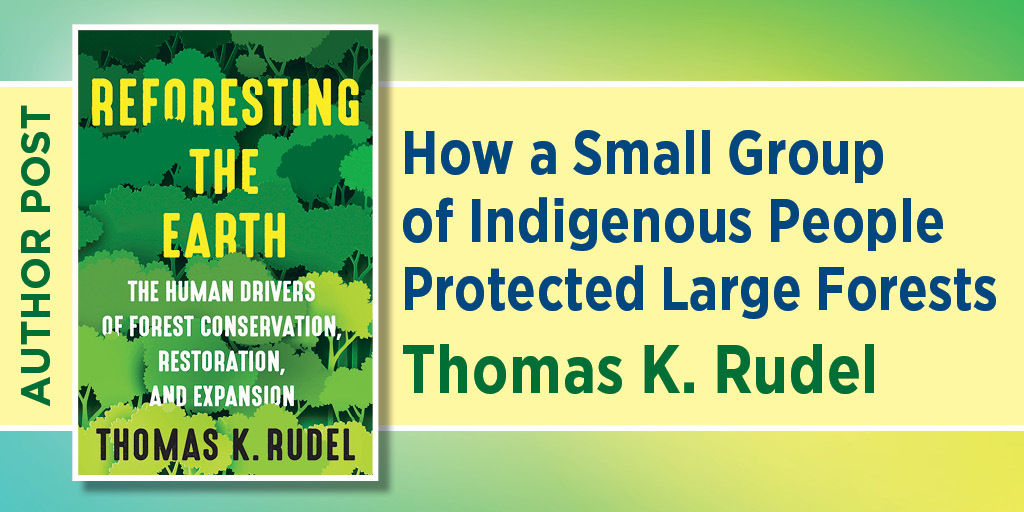The Power of the Shuar:
How a Small Group of Indigenous People Protected Large Forests
Thomas K. Rudel

Affluent farmers and wealthy groups of investors have continued to destroy extensive tracts of tropical forests in sub-Saharan Africa, Asia, and Latin America over these past forty years. The ongoing loss of these old growth forests has intensified the biodiversity crisis and accelerated climate change. Governments and wealthy foundations have tried to halt the forest losses, in many instances to no avail. Against this grim tableau of environmental destruction, the abilities of small groups of Indigenous peoples to preserve forests have stood out as examples of how to conserve natural resources. A recent global study of forest protection found that Indigenous preserves provide as much protection to forests as national parks. A brief history of Indigenous forest protection in the upper reaches of the Ecuadorian Amazon, sketched out here, illustrates how Indigenous peoples have become so effective at protecting tropical forests.
The Shuar, an Indigenous people, occupy a particularly humid stretch of the Amazon basin where the Andes and the foothills of the Andes rise out of the Amazon plain. The two photographs capture the essential aspects of this beautiful, fragile landscape: The first looks uphill from the Amazon into the Andes and the second captures its verdant dimension. Abundant rains in the region encourage the germination and propagation of tree seedlings, even in cattle pastures.
“Shuar,” in their language, means “people.” The generic quality of this name suggests how the Shuar were isolated for centuries in their rainforest homesteads. This isolation, however, vanished in the twentieth century. First came the Catholic priests, who arrived with the intent to evangelize the Shuar. Settlements grew up around the churches, populated by mestizos who followed the priests down into the Amazon basin. The mestizos soon began to claim the forested lands where Shuar gardened and hunted for themselves. The increased contact and conflict spurred ethnogenesis among the Shuar. They came to see themselves as a distinct people, different in their forest-based livelihoods from the mestizos. They lived in isolated homesteads in the rain forests. They were a small group. In the 1950 Ecuadorian census, only 4,000 people self-identified as Shuar.
The struggle for land between the Shuar and mestizos intensified after 1950. The Shuar, with the help of the priests, organized into villages and then into a federation of villages. Doing so allowed the Shuar to gain political power, and their clout eventually had an impact on national Ecuadorian politics. By 1990, Shuar villagers had managed to obtain titles to approximately half of the arable lands in southeastern Ecuador. The struggles with mestizo colonists left the Shuar with feelings of grievance about lost lands and a conviction that they could accomplish goals through collective action. At the same time, the Shuar maintained a pattern of voluntary simplicity in household consumption. They did things on a small scale, sufficient to meet their household needs. To this end, they gardened intensively, chopped down individual trees, and raised only small numbers of cows and pigs.
A recent global study of forest protection found that Indigenous preserves provide as much protection to forests as national parks.
The appropriation of forested lands by the Shuar and mestizos did not end during the 1980s. Large tracts of rugged terrain in the Kutucu Range of the eastern Andean foothills remained open to all claimants in the 1990s. Worried about a continued influx of mestizo colonists and buoyed by their success in obtaining land titles, Shuar federation officials proposed a large, protected area in the Kutucu Range. Government quickly approved the proposal for a park, but it would only be a park on paper, and there were no real restrictions over land use. During the next two decades, small numbers of Shuar moved into the Kutucu Range and set up homesteads in the narrow valleys. In 2008, Shuar officials recruited several international, conservation-oriented partners, CARE and the European Community, to finance and implement a plan for forest protections in the new park. Through a series of negotiations, the assembled parties constructed a land-use plan that allowed Shuar to farm small patches of land in the valleys and designated as protected areas the larger tracts of forested land on the ridges of the foothills. This Shuar accepted these restrictions. The voluntary simplicity and correspondingly small scale of Shuar household economies made it possible for them to meet their consumption goals on the small patches of land in the narrow confines of the valleys in the Kutucu mountains.
In sum, two conditions enabled forest protection by the Shuar. First, they mobilized and defended their ancestral homelands, with some success, against incursions by outsiders. These mobilizations continued to pay off when the Shuar Federation later proposed the new protected park in the Kutucu Range, built a coalition of like-minded organizational partners, and drew up with them a set of land-use restrictions for the forested lands of the park. Second, the Shuar, like many other Indigenous groups, have long practiced forest-based livelihoods. Even as they have become more immersed in urban-oriented consumer societies, Shuar households have retained a commitment to voluntary simplicity in patterns of production and consumption. They limit their cultivation of crops, harvesting of trees, and rearing of livestock, which in turn reduces their desire to convert forests into fields and pastures. For these reasons, the Shuar have become very effective agents of forest protection during the twenty-first century.
Thomas K. Rudel is Distinguished Professor Emeritus of Human Ecology and Sociology at Rutgers University and the author of Reforesting the Earth: The Human Drivers of Forest Conservation, Restoration, and Expansion.










